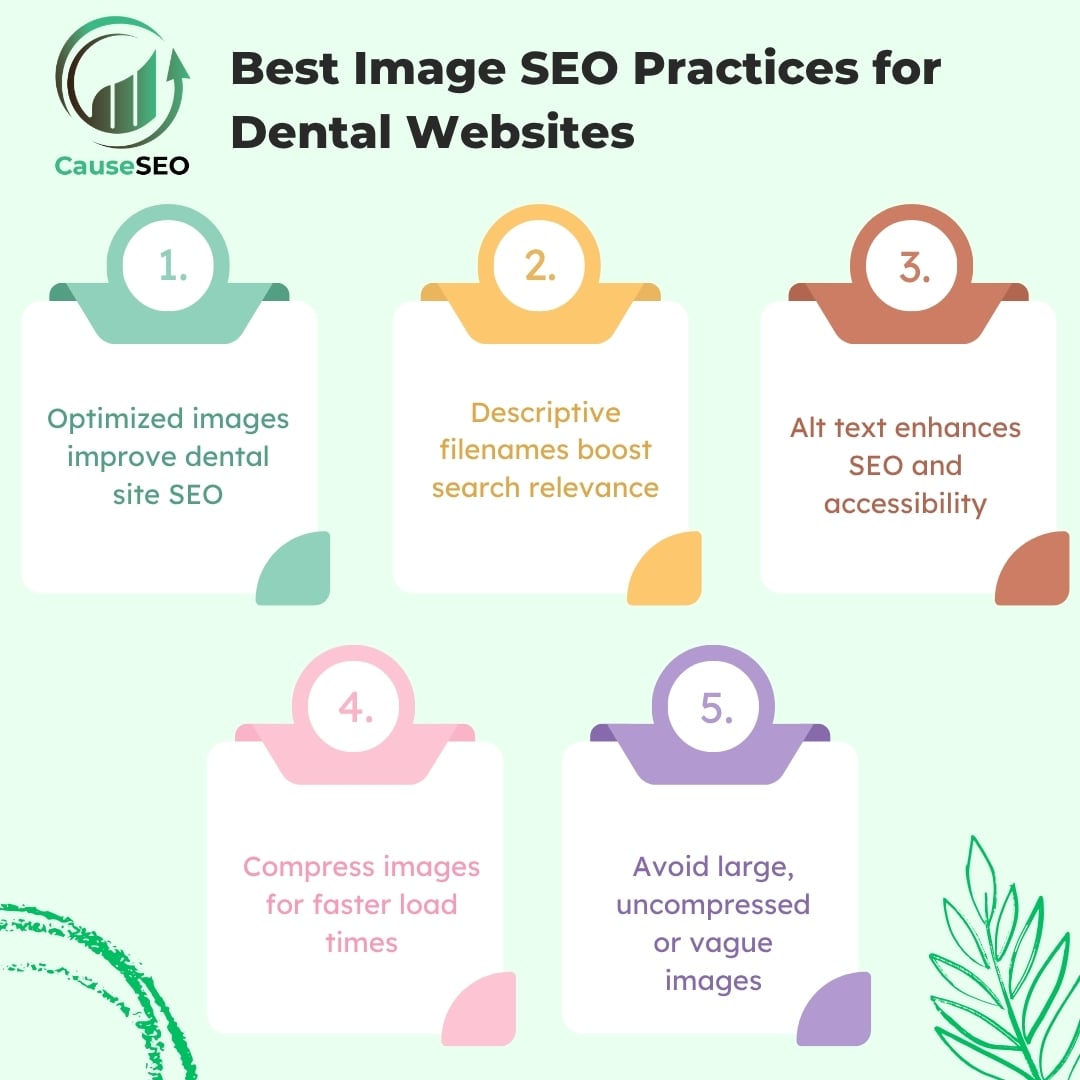Image SEO is the process of optimizing images so they load quickly, appear in search results, and support the overall goals of your website. For dental practices, this matters more than you might think. Incorporating image SEO practices for dental websites, including fast, well-named, and properly described images, improves your website’s speed, accessibility, and visibility—especially in local search and Google Images.
In this guide, we’ll walk through how dental SEO experts use image optimization to enhance search performance, improve user experience, and make dental websites look and feel more professional.
Why Image SEO Matters for Dental Websites
Improves Page Load Speed and Performance
Large or unoptimized images are one of the main reasons websites load slowly. For dental websites, slow speeds lead to higher bounce rates—especially on mobile—and can hurt your dental SEO performance.
When images are compressed and correctly sized, pages load faster. This helps your SEO for dental office pages rank better and creates a smoother experience for visitors.
Enhances User Experience and Trust
People expect to see photos of your dental team, office space, and treatments. Fast-loading, clear visuals help build trust. They make the site feel up to date, transparent, and real—especially important for new patients deciding whether to book.
Increases Image Search Visibility
Google Image Search is another place where patients might discover your brand. Optimized images—complete with filenames, alt text, and schema—can show up in search results, bringing in extra traffic and visibility for your services.

Best Image SEO Practices for Dental Websites
Use Descriptive, Keyword-Rich Filenames
Instead of uploading “IMG_2345.jpg,” rename the file before uploading. Use plain, specific language and local terms when relevant:
✅ dental-cleaning-red-bank.jpg
✅ before-after-teeth-whitening.jpg
This helps Google understand what’s in the image and improves local relevance.
Optimize Alt Text for Accessibility and Relevance
Alt text is what screen readers use for visually impaired users—and what Google uses to understand the image.
✅ Example: “Patient receiving teeth whitening treatment at ABC Dental Red Bank”
It should describe the image clearly without keyword stuffing. Good alt text improves both dental website SEO and ADA compliance.
Compress Images Without Losing Quality
Large files slow your site down. Use compression tools like:
- TinyPNG
- ShortPixel
- ImageOptim
They reduce file size while maintaining visual quality, which helps your pages load faster and keeps Google happy.
Use Proper File Formats
- JPEG: Best for photos (staff, patients, office).
- PNG: Great for graphics or images with transparency.
- WebP: Modern format that combines small file sizes with good quality.
Choose the format based on the image type. WebP is especially helpful for improving page speed scores.
Implement Responsive Images for Mobile
Use HTML attributes like srcset to make sure your images scale properly on all devices. This ensures that your mobile users aren’t downloading full-sized desktop images, keeping load times fast.
Add Structured Data (ImageObject Schema)
Using schema helps Google better understand your images. Adding ImageObject markup increases the chances your visuals show up in rich results and local listings.
Place Images Contextually
Images should match the topic of the page. A photo of dental braces belongs on your Orthodontics page, not your Dental Crowns page. Keeping images relevant boosts content quality and keyword alignment.
Use Captions When Appropriate
Not every image needs a caption, but if it adds context—like a testimonial quote or explanation of a procedure—it can improve user engagement and make your content easier to scan.

Where and How to Use Images on a Dental Website
Homepage
Showcase your team, happy patients, and clean, modern facilities. This creates a great first impression and builds immediate trust. Use lightweight hero images for faster loading.
Service Pages
Add images of real procedures, before-and-after transformations, or product visuals (e.g., Invisalign trays, dental implants). These help patients understand what to expect and make services feel more approachable.
Blog Posts
Support your educational content with helpful visuals—diagrams, stock images, or photos from your practice. Images make long-form content easier to digest and more shareable.
Location Pages
Include photos of your office’s exterior, interior, and even parking instructions. These details support local dental SEO by improving local relevance and trust signals.
Common Image SEO Mistakes to Avoid
Uploading Large, Uncompressed Images
Heavy files slow down your site and push you down in search rankings. Always compress before uploading.
Ignoring Alt Text or Using Vague Descriptions
“Image” or “photo” doesn’t help anyone. Write clear alt text that explains the image’s content and context.
Stuffing Keywords into Every Alt Tag
Adding the same keyword to every image looks spammy. Describe the image naturally, and use keywords only when relevant.
Using Too Many Images Without Purpose
A cluttered site feels overwhelming. Don’t add visuals just to fill space—use them where they help communicate something useful.

Tools for Image SEO Optimization
Compression and Format Tools
- TinyPNG and ShortPixel for bulk compression.
- ImageOptim for Mac users.
- Squoosh for quick browser-based edits.
These tools let you reduce file size without damaging the look of your photos.
SEO Analysis and Monitoring
- Screaming Frog or Sitebulb: identify missing alt text, oversized files, or image errors.
- Google Search Console: track how Google indexes your images and whether they’re driving clicks.
These tools help you spot issues and measure progress.
FAQs – Image SEO for Dental Websites
What is image SEO and why does it matter for dentists?
Image SEO involves optimizing visuals for speed, relevance, and search visibility. For dentists, it builds trust, improves user experience, and helps attract more local patients.
How do I write good alt text for dental images?
Describe what’s in the image using plain language. Be specific (e.g., “Dental hygienist performing teeth cleaning”) and include a location if it makes sense.
What size should my images be for fast loading?
Aim for under 150KB for most images. Compress large files and scale dimensions to what’s needed for display. For example, don’t upload a 2000px-wide image if it only displays at 800px.
Should I use stock photos or real images on my dental site?
Real images are always better. They feel more authentic and build trust. If you must use stock images, choose professional, clean ones that match your brand style.
Can image SEO improve my Google rankings?
Yes. While image optimization alone won’t rank your site, it supports faster loading, better engagement, and image visibility—all of which help your overall dental SEO strategy.
Do I need schema markup for my images?
Schema isn’t mandatory, but it helps. Adding ImageObject schema can boost your image’s chances of appearing in rich snippets or image search results.
Conclusion
Image optimization is one of the most effective and straightforward ways to improve your dental website SEO. From faster load times to better accessibility and stronger Google rankings, the benefits go beyond technical fixes—they enhance your entire online presence.
As Google continues to prioritize mobile-first performance and user experience, image SEO will stay essential.
Reach out to the team at Cause SEO to audit your visuals and apply image SEO best practices that support growth and visibility.

